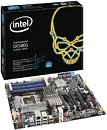- Joined
- Oct 9, 2007
- Messages
- 47,306 (7.52/day)
- Location
- Hyderabad, India
| System Name | RBMK-1000 |
|---|---|
| Processor | AMD Ryzen 7 5700G |
| Motherboard | ASUS ROG Strix B450-E Gaming |
| Cooling | DeepCool Gammax L240 V2 |
| Memory | 2x 8GB G.Skill Sniper X |
| Video Card(s) | Palit GeForce RTX 2080 SUPER GameRock |
| Storage | Western Digital Black NVMe 512GB |
| Display(s) | BenQ 1440p 60 Hz 27-inch |
| Case | Corsair Carbide 100R |
| Audio Device(s) | ASUS SupremeFX S1220A |
| Power Supply | Cooler Master MWE Gold 650W |
| Mouse | ASUS ROG Strix Impact |
| Keyboard | Gamdias Hermes E2 |
| Software | Windows 11 Pro |
Intel's Desktop Board division is readying two new high-end socket LGA1366 motherboards under its Extreme Series line. The company's last high-end LGA1366 motherboard, the DX58SO "SmackOver", was released more than 25 months ago in November 2008, when the first Intel Core i7 processors came to be. The new motherboards are up to date in terms of features. They use the latest Rev. 13 X58 northbridge, all solid-state capacitors, support the latest LGA1366 processors out of the box, and feature USB 3.0 and SATA 6 Gb/s support. The two motherboards consist of DX58SO2 "SmackOver II", and its "lite" variant, the DX58OG.
The DX58SO2 uses digital PWM CPU power circuit, a sporty blue heatsink cluster over the northbridge, VRM area, and southbridge, with heat spread between the northbridge and VRM using a heat-pipe. It features six internal SATA 3 Gb/s, two internal SATA 6 Gb/s, and two eSATA 3 Gb/s ports, two USB 3.0 ports, 8-channel HD audio, and expansion slots that include three PCI-Express 2.0 x16 (x16/x16/NC or x16/x8/x8), two PCI-E x1, and one PCI.


The DX58OG uses the same exaxt PCB as the DX58SO, except that a lot of features are downscaled. The CPU VRM has fewer phases, although USB 3.0 and SATA 6 Gb/s ports are unaffected, there are no eSATA ports, and a 6-channel HD audio CODEC instead of 8-channel, and the third PCI-Express x16 slot is reduced to x1. Both boards feature certain new features that Intel is introducing with its latest Extreme Series boards, namely, BIOS Vault Technology that helps recover BIOS, a Back-to-BIOS button, and a more efficient inter-phase load balancing mechanism. Intel's new Desktop Boards should be available anytime soon, probably from early January.
View at TechPowerUp Main Site
The DX58SO2 uses digital PWM CPU power circuit, a sporty blue heatsink cluster over the northbridge, VRM area, and southbridge, with heat spread between the northbridge and VRM using a heat-pipe. It features six internal SATA 3 Gb/s, two internal SATA 6 Gb/s, and two eSATA 3 Gb/s ports, two USB 3.0 ports, 8-channel HD audio, and expansion slots that include three PCI-Express 2.0 x16 (x16/x16/NC or x16/x8/x8), two PCI-E x1, and one PCI.


The DX58OG uses the same exaxt PCB as the DX58SO, except that a lot of features are downscaled. The CPU VRM has fewer phases, although USB 3.0 and SATA 6 Gb/s ports are unaffected, there are no eSATA ports, and a 6-channel HD audio CODEC instead of 8-channel, and the third PCI-Express x16 slot is reduced to x1. Both boards feature certain new features that Intel is introducing with its latest Extreme Series boards, namely, BIOS Vault Technology that helps recover BIOS, a Back-to-BIOS button, and a more efficient inter-phase load balancing mechanism. Intel's new Desktop Boards should be available anytime soon, probably from early January.
View at TechPowerUp Main Site






 , why dont they stand on 1 socket type and not confusing us :shadedshu
, why dont they stand on 1 socket type and not confusing us :shadedshu
